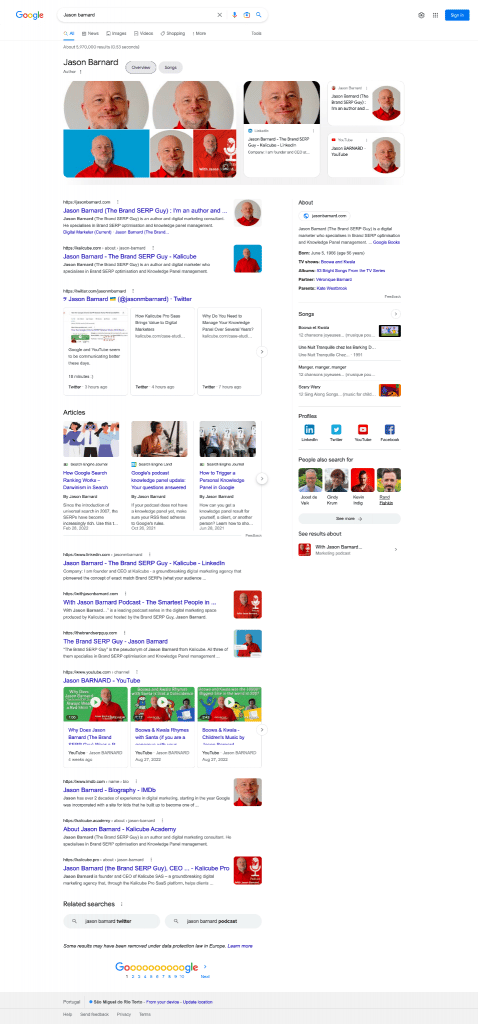Entity Description in SEO: What You Need to Know

Simple Definition of Entity Description
An Entity is a thing (person, company, podcast, book, musical artists etc). The Entity Description is a summary that describes who the Entity is, what it does and which audience it serves. In SEO, the Entity Description is used to provide Google with the important information directly.
See below for WHY this is important.
What Does an Optimised Entity Description Contain?
Three Important Components:
- The Entity Description should provide a clear and factual summary of who the Entity is, what it does and which audience it serves. It should also be optimised for Google NLP (Natural Language Processing) to ensure that Google fully understands. The Kalicube Pro SaaS Platform provides Entity Description writing and copywriting tools that use Google’s own NLP analysis to give you the insights you need to write exceptional Entity Descriptions and be sure that Google understands them. Other NLP analysers are fine to use as well but ideally, you should use Google’s.


- The Entity Description should have an Executive Summary starting with a semantic triple to introduce the Entity that has the Entity’s subtitle as the first object. Importantly, this is key if you want to change the subtitle in a Knowledge Panel – here is a case study about changing the subtitle in a Knowledge Panel.
Example: Jason Barnard is an author and digital marketing consultant. The author was mentioned first and therefore there is a high chance Google will choose this as the subtitle for the Knowledge Panel as it follows the rule that “the first mentioned is the most relevant and important”.

- The Description Extension that expands the Executive Summary in a hierarchical and modular way. Hierarchical means that you need to order the facts, starting with the most relevant and important and ending with the least relevant and important. Google’s rule is very simply “the first mentioned is the most currently relevant and important”. Modular means that you need to break it down into logical sections (or chunks) that each describe one facet of the Entity, which makes the description modular so it can be easily adapted for different use-cases.
Learn how to write a clear Entity Description that Google will surely understand here>>
How Do Entity Descriptions Fit Into Brand SERP Optimisation and Knowledge Panel Management?
Entity Descriptions are a crucial key to optimising Brand SERPs and managing Knowledge Panels. Therefore, it is important to know how to formulate them clearly in order to prevent misunderstandings and confusion.
Knowledge Panel Management
For Knowledge Panels, the Entity Description is foundational. Google is still focused on text, so if it confidently understands your Entity Description, you have a HUGE advantage. Having a clear explanation is absolutely key to Google.
Adding the Entity Description to Schema Markup on your Entity Home is hugely helpful: Schema markup is Google’s “native language”, and is therefore a “direct” communication with Google.
Google learns by repetition. Seeing that description repeated on multiple authoritative, trusted and relevant sources will build its confidence in its understanding of the Entity Description. That means duplicating this Entity Description across all the Entity’s profiles on trusted sources is important – repetition builds confidence in understanding.
Brand SERP Optimisation
The Entity Description is less important for Brand SERPs. However, Google will use and re-use a well-written Entity Description as a quick summary or appetiser because it gives searchers a good idea about what they can expect on the other side when they click on this specific search result. This makes Entity Descriptions important for both your Brand SERP and UX (User Experience).
As you can see from this screenshot, Google will pick the relevant part of your modular description for each result. There is some repetition, but Google selects the part of the Entity Description that is most relevant to the platform.
- On Jason’s personal site, it is “Jason Barnard (The Brand SERP Guy) is an author…”
- For the professional site (Kalicube Pro), it uses “Jason Barnard is the founder and CEO of Kalicube”
- On The Brand SERP Guy’s site it uses “The Brand SERP Guy is the pseudonym of Jason Barnard”
- On LinkedIn it focuses on the company (logical since LinkedIn is B2B)
- On IMDB Google selects the part about the cartoon characters
As you can see, Google understands the context of each site and selects the “chunk” that is appropriate for that site’s audience.
If your Entity Description is structured, hierarchical and covers each facet clearly in a “chunk”, Google deals with the repetition for you. Genius !

So, Google deals with the duplicates by using context to extract the most relevant part of the modular Entity Description.
Importantly, the repetition helps to build the trust that Google places in any page containing the Entity Description (e.g. a podcast page). That, in turn, will help the page to rank better on your Brand SERPs because Google understands the relationship between the page and the Entity being searched for. But always remember that there are only 8 to 12 blue links with a description on any Google SERP, so not every profile will rank !
That said, by analysing the ones that repeat the Entity Description that rank on your Brand SERP, you can easily see to what extent Google has understood your multiple facets.
Every entity (person, company, book, music group…) has multiple facets. A good Entity Description written in a modular structure helps Google understand each of those facets, and represent them accurately and helpfully to the subset of Google’s users who are its audience.
Learn how to write Entity Descriptions that Google loves. Book a call with Jason Barnard now to get started.




